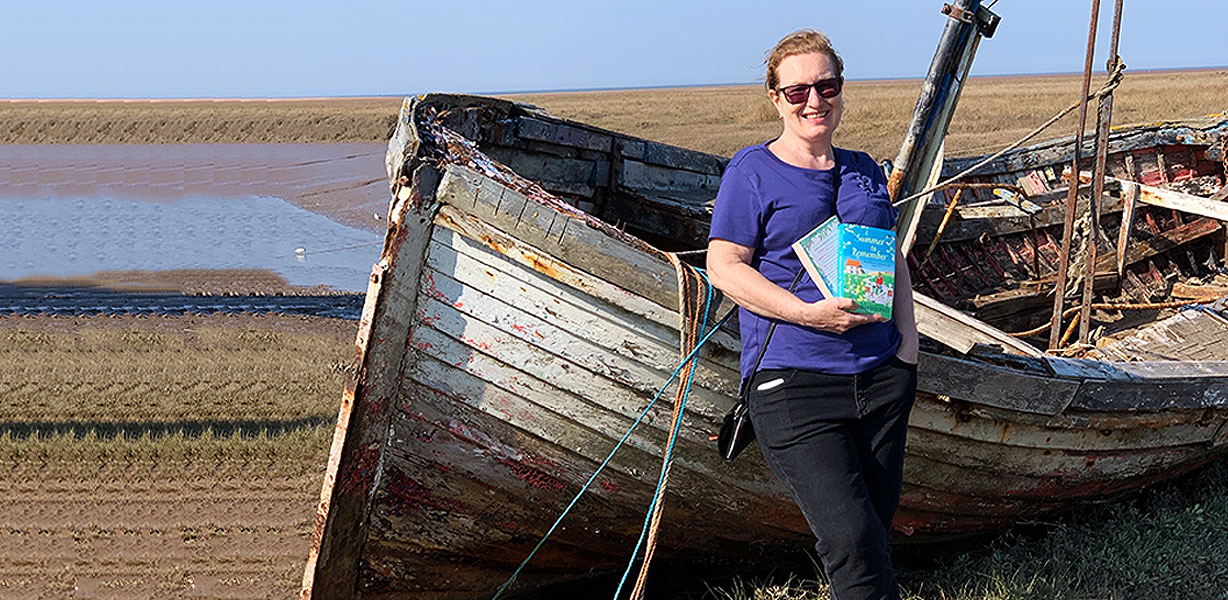I love sunshine, I love the sea and I love my job as an author. These three things came together beautifully when I took a research trip to the north Norfolk coast in a heatwave last summer to decide where to place the tiny village in A Summer to Remember.
I booked into a pub in the village of Thornham and, beginning at Hunstanton, worked my way east along the coast. I wasn’t looking for a resort but somewhere remote to place an internet ‘not-spot’.
In case you’re unfamiliar with the term, a ‘not-spot’ is a place passed over by phone signals and broadband. If you’re trying to check Twitter or phone your beloved, not-spots are frustrating places that render your smart phone about as much use as a paper-weight. (Actually, I did use mine as a paperweight when sitting in the pub garden writing notes …) I’d researched connectivity problems in rural areas.
I understood that without those green cabinets that dot our streets the chances of having broadband access are limited. I knew that satellite broadband was affordable but that the necessary dish was a no-no in certain conservation areas and on the fronts of some listed buildings. I discovered that all kinds of structures were used as platforms in the absence of standard mobile phone masts – church spires, silos and even one of those windmills in the sea.

I began to wend my way through villages, salt marshes and nature reserves, beaches, harbours and winding lanes, abandoning my car to wander for hours in the beating sun, phone in hand to check out the mobile signal or to take pictures of the gorgeous scenery.
Over a glass of wine in the garden of the pub, the sun setting in a blaze of colour, I took out my notebook and pulled together the perfect place for a not-spot.
Between Thornham and Titchwell, I drew in a headland that juts out to sea in place of part of the salt marshes. Much higher than the surrounding land it would be reached via a lane that climbs steeply through the pinewoods. It would be in a conservation area and the landlines would be of the old copper kind.
The reason that the cottage Clancy Moss goes to live in is a round house is that there’s a farm quite close to where I live where the original structure is, indeed, round. I searched around and found quite a few round houses, a bit like a biscuit barrel my mum once had, and found one in Northamptonshire that had recently been up for sale. Its floor plans were there for me to adopt and so The Roundhouse and Roundhouse Row of cottages were born.

A seaside village, even one in an elevated position, needs a beach or two, and The Leap came about when I was thinking about my childhood in Malta when I used to leap into the sea from heights I’m sure I never confessed to my parents. I was pretty sure local teenagers would have fun with it.
I ran a mini-competition for the members of my street team to name the village and one, Manda, suggested Nelson’s Bar because of Horatio, Lord Nelson being born in north Norfolk and ‘bar’ referring to a bar of land, i.e. the headland on which the village stands. I had a bit of fun with the Nelson connection, calling the B&B the Duke of Bronte because that was Nelson’s secondary title and the tiny bar within it – yes, Nelson’s Bar. And Hero Aaron has a rescue dog who has only one eye. What could I call him but Nelson?
Here’s my map of Nelson’s Bar. You can see the homes of the major characters: Aaron’s cottage and his parents’ house, with an annexe for Great Aunt Norma; Genevieve’s cottage that causes so many problems when it needs structural repairs; Dilys and Ernie who have been married for so long they can’t live with each other and can’t live without; the home of Aaron’s cousin Jordy, the son Harry who troubles Jordy so much; and the cottage where Rory lives with his mum.

I’ve spent so much time in Nelson’s Bar that I feel I can walk the clifftops and smell the salt air mingling with that of sausages cooking as I pass by the B&B, watch sunlight dancing on blue waves, admire the geometric shapes of Aaron’s Japanese garden with the sea beyond and hear the echo of voices up the stairs in the centre of The Roundhouse. I see the chalk and flint cottages with clay-tiled roofs, the dusty hedges, the sloping, winding lanes and the sand of Secret Beach. It’s a beautiful place.
I loved creating Nelson’s Bar and I hope readers love it too.



